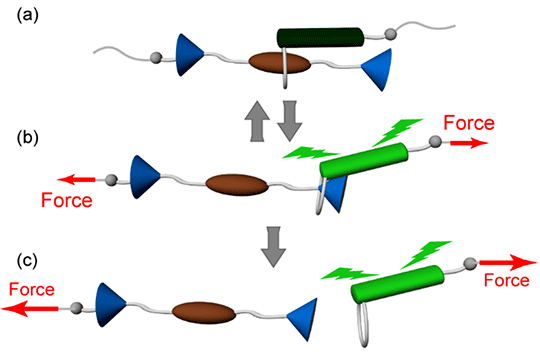Jun 28 2021
At the Tokyo Institute of Technology, researchers have developed polymers infused with a stress-sensitive molecular unit that react to external forces by turning on their fluorescence.
 Schematic illustration of the operation of a rotaxane-based mechanophore, displaying (a) force-free state, (b) reversible, and (c) irreversible responses. Scientists explored a curious interlocked molecular architecture called “rotaxane” and reported a new type of mechanophores response that is both reversible and irreversible depending on the magnitude of applied force without scission of chemical bonds. Image Credit: Journal of the American Chemical Society.
Schematic illustration of the operation of a rotaxane-based mechanophore, displaying (a) force-free state, (b) reversible, and (c) irreversible responses. Scientists explored a curious interlocked molecular architecture called “rotaxane” and reported a new type of mechanophores response that is both reversible and irreversible depending on the magnitude of applied force without scission of chemical bonds. Image Credit: Journal of the American Chemical Society.
The team has shown that the fluorescence depends on the magnitude of the force and demonstrated that it is feasible to detect both reversible and irreversible polymer deformations, thereby paving the way to finding new force regimes in polymers.
Apart from driving physical motion, mechanical forces can also be responsible for inducing chemical changes in regulated and productive methods, thereby enabling suitable material properties.
One method to perform this is to introduce what is called a mechanophore into the material, molecular units that are sensitive to strain or stress. Particularly, mechanochromic mechanophores, which tend to change their optical properties in reaction to mechanical stimuli. They are extremely useful when it comes to measuring their local mechanical surrounding.
However, the response mechanism at play in a majority of the mechanophores includes the severing of chemical bonds. At the same time, huge mechanical forces need to be activated and their reaction is not reversible in general.
For such problems to be addressed, scientists, guided by Professor Yoshimitsu Sagara from Tokyo Institute of Technology (Tokyo Tech), had earlier designed supramolecular mechanophores that display quickly reversible on or off switching of fluorescence without any scission of covalent bonds. The next difficulty was to find whether both reversible and irreversible mechanoresponses can be elicited from the same molecular motif.
In a new study published in the Journal of the American Chemical Society, the researchers examine this question using a strange molecular architecture known as “rotaxane” in which a dumbbell-shaped molecule is threaded via a “ring” in such a way that they are interlocked mechanically, i.e. the “ring” cannot normally be pulled out.
The researchers illustrate a new kind of mechanophore response that can either be reversible or irreversible, based on the magnitude of the applied force. They achieved this by fixing a quencher-emitter pair to the rotaxane and choosing suitable sizes of ring and stopper moieties.
When there is no force applied, the attractive interaction keeps the emitter-containing ring near the quencher fixed on the rotaxane's axle, so that the emission is quenched. Upon applying a weak force, the emitter is moved away from the quencher, and its fluorescence is turned on. This effect is reversible, unless the force is sufficiently high to push the ring past the stopper so that irreversible dethreading occurs.
Yoshimitsu Sagara, Professor, Tokyo Institute of Technology
A meticulously designed set of different rotaxanes was analyzed by the researchers and it was shown that a mixture of the suitably chosen ring and stopper moieties with the correct size is critical to achieving interlocked structures that exhibit such dual response.
Scientists from Tokyo Tech joined hands with Swiss partners from the University of Fribourg’s Adolphe Merkle Institute to integrate the new mechanophores into elastic polyurethane rubbers.
Such materials tend to display reversible fluorescence changes over several stretch-and-release cycles to low strains, as a result of the shuttling function. On the other hand, permanent variations were noted when the rubbers were subjected to recurrent deformations to high strains due to dethreading of the ring from the axle.
This mechanism allows one, at least conceptually, to monitor the actual deformation of polymer materials and examine mechanical damage that were inflicted in the past on the basis of an optical signal.
Yoshimitsu Sagara, Professor, Tokyo Institute of Technology
Sagara speculated on the possible consequences of their study findings.
Extending the current library of mechanophores with our rotaxane-based candidates would be useful for studying the mechanical properties of not only polymers but also cells and tissues, as our mechanophores can respond to much smaller forces compared to those involving chemical bond scission.
Yoshimitsu Sagara, Professor, Tokyo Institute of Technology
Journal Reference:
Muramatsu, T., et al. (2021) Rotaxane-Based Dual Function Mechanophores Exhibiting Reversible and Irreversible Responses. Journal of the American Chemical Society. doi.org/10.1021/jacs.1c03790.